|
Mr. Steven S., my Canadian neighbor
who has also built the So Long,
Quarter Pint, and
Ace Whizard models from plans found on Airplanes and
Rockets, is now about to undertake the Pacer 1/2A pattern model that was featured
in the August 1974 edition of American Aircraft Modeler. It originally used foam
wings, so I'm guessing he will be drawing up plans for a balsa version, but we'll
have to wait an see. I have every confidence that Steven's rendition will do the
craft's designer, Owen Campen, proud. Here are some
construction photos.
See Steven's Bee-Tween,
Ace Whizard, Simple
Citabria, Simple Duster,
Quarter Pint,
So-Long, and
Ace Pacer models.
Pacer
At last, true pattern capabilities are matched to small field operation.
by Owen Kampen
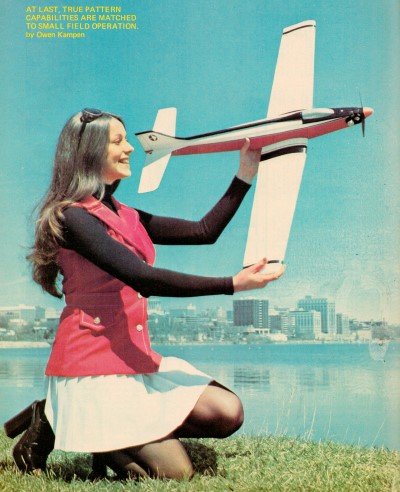 Everyone knows about little 049-powered RC models.
They are twitchy, fragile, buzzy things that dart around in a state of semi-controlled
agitation while cluttering up the sky. They get in the way of the serious fliers
with their serious planes. They are OK for the kids, but a grown man who wants to
experience what RC is really all about with a really groovy responsive ship has
to have a six-foot, six-pound, 60-powered job, complete with at least six channels.
Right? ... WRONG! Everyone knows about little 049-powered RC models.
They are twitchy, fragile, buzzy things that dart around in a state of semi-controlled
agitation while cluttering up the sky. They get in the way of the serious fliers
with their serious planes. They are OK for the kids, but a grown man who wants to
experience what RC is really all about with a really groovy responsive ship has
to have a six-foot, six-pound, 60-powered job, complete with at least six channels.
Right? ... WRONG!
Today's state of the art has changed all this, and a new breed of clean responsive
craft is on the way. They not only look like, but fly like, their big competitive
brothers; and at the same time offer some very considerable bonuses. In an age of
growing shortages of energy, you can now have five and ten minute flights on one
or two ounces of fuel. Long weekend trips to the field can be supplemented by a
walk to a nearby playground, as all you need for an hour's session can easily be
carried in two hands.
A few 60 pilots have been impressed enough to state their belief that this could
be a great way to sharpen their competitive skills, and cut down on those 30 gallon
summers. A study of the plans will indicate ease of assembly, with a minimum investment
of time and money.
The Pacer may well turn out to be the father of this whole new family of RC craft.
The concept is an audacious one, made possible by a combination of three essential
elements: the availability of high-quality miniaturized RC gear, an engine capable
of delivering an immense amount of power per ounce, and imagination. The three ingredients
are not new; this particular combination is.
DESIGN PHILOSOPHY

In the air, the Pacer shows the classical lines of its sleek
pattern lineage.

Here's a design that can be honestly touted as a miniaturized
version of a 60-powered competition ship. Earlier versions of the model were flown
by AAM's editorial staff - it's the real thing.
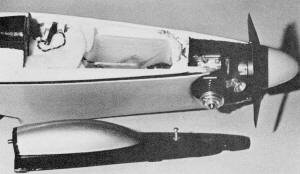
The one-piece hatch is removed to show the Sullivan two-oz. tank
installation. Airborne batteries are located, in foam, just aft of the tank.
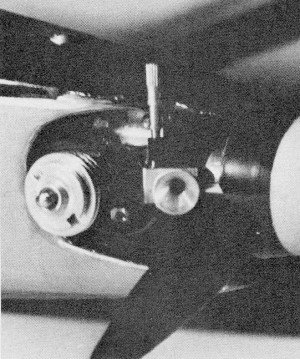
The Kirn-Kraft needle valve ensures peak setting for the Cox
Tee Dee 049. Maximum performance, as with the 60-sized jobs, requires a screaming
engine.

The sub-rudder is an aerodynamic necessity, but it also serves
as a landing skid. The same holds true for the raked-down wing tips, which are the
author's trademark.
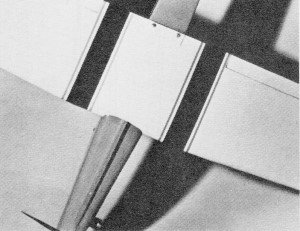
Notice anything different here? The lazy man's retract system
isn't: "Let it all hang out." Rather: "Leave 'em altogether off."
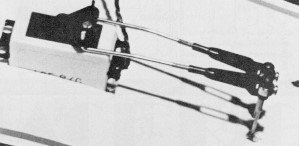
Aileron linkage is per usual pattern ship installation. Note
that the servo is a friction and tape fit. A piece of 3/32" O.D. brass tube is slipped
over the 1/16" wire horns to accommodate the horn attachments.
It is not generally understood that an airplane, large or small, is first of
all an idea. Sometimes vague in the beginning, the idea is filtered through past
experience, practical considerations of available materials and methods, a clarification
of goals, and a measure of intuition. When successful, the result is a collection
of parts moving together as one to form a new entity - which sometimes, though rarely,
equals or exceeds the hopes of its creator.
In terms of experience, the last dozen years have witnessed the birth of over
sixty original RC designs by the author. There have been successes and failures,
and the latter have been the teachers. Risk is always the constant companion and,
from this, we learn to enjoy the trip - regardless of the outcome. Nothing is ever
wasted, for the failures are seen as a necessary part of learning to bracket the
errors.
Always there are the decisions, and each usually represents a trade-off - but
not always. A designer often feels he must choose between aesthetics and performance
which, in turn, results in either an easy-to-build "Ugly Box" or a highly complex
"Slick Brick." This assumption that it has gotta be this or that is false, for the
underlying premise of all good design is simply that "Form must follow function."
Neither ugliness nor complexity ever made a model fly better. If either type worked
well, it was not because of, but in spite of, these limitations. The current practice
in model aircraft design is often so simple that anyone can become an expert overnight
by following one basic rule: "If it don't fly too good, stick on a bigger engine."
It is almost incredible how successful this method is, and surely helps explain
the popularity of using larger and larger engines on increasingly smaller airplanes.
Effective as the method might be, it does not really present much of a design challenge.
The Pacer is the result of a challenge, a desire to see how much performance could
be coaxed forth, while working within the confines of an RC payload, on one hand,
and the available power of the Cox Tee Dee 049-051 on the other.
The goal was not to achieve a VTO trip to Mars, but rather to find a harmonious
relationship of parts which would result in the superior flight characteristics
usually associated with larger, high-powered pattern planes.
HISTORY
While not a committee, several modelers were involved in the development of the
concept.
The plane that triggered the action was a P-51 Ace Warbird fitted with rudder,
elevator, strip ailerons and a hot Cox 051. Tom Runge had brought it to Madison
on a visit in the Summer of '73. His flight demonstrations included low inverted
passes, and most everything else in the book. None of us had ever seen a 1/2A ship
perform so outstandingly, which was a credit to both pilot and plane. Riding home
from the field, a discussion among Tom, Frank Baker and myself explored the idea
of taking another look at small, high-performance models, which would begin where
the Whizard and Warbird left off. We agreed that it was well within the realm of
the possible and, if successful, might be just the thing to make the small RC plane
respectable. Work started the following day.
While Frank proceeded with a highly modified Whizard - a cabinless mid-wing,
I was approaching the problem from another angle. Under Tom's watchful eye, a new
design began to take shape. All of the inherent stability of the Whizard was designed
out, to achieve the desired neutral stability of a pattern ship. Moments were lengthened,
to smooth out elevator response, and every part made as clean as possible. Following
Romey Bukolt's Warbird lead, the retractable landing gear problem was solved in
the simplest possible manner - elimination. (An old artists' adage advises: when
in doubt-leave it out!) In a spirit of fun, it was called the Mach None. Two prototypes
were cut before Tom left for the NATS and home.
First flights of all three planes took place about the same time, with Frank
and I in Madison and Tom in Omaha.
All tests exceeded anything we could have hoped for, with absolutely no resemblance
to any previous experience with planes of this size and power. Elimination of the
leading gear reduced weight and drag to a point where performance took a giant step:
Large, open looping maneuvers were possible. Aileron response was crisp and precise,
granting true axial control - but not at first. With airspeeds in the 60-70 mph
range, response was so quick that the first flights were all over the sky, and two
rolls resulted when one was intended. Some of the squarest loops yet seen at our
field were caused by the mere twitch of a thumb. This problem was solved by simply
reducing control surface throws.
When the engine quit, the clean machines kept right on going, and none of us
could hit the field with our first five landings. It was rather incredible to come
across the fence at less than ten feet of altitude, and watch the damn things sail
clear across the field into the brush. In time, we learned to kill off speed with
a combination of dead stick loops, rolls and a nose high attitude. Here, the low
speed stall characteristics of the Ace foam wing, in combination with light wing
loadings, allowed "wheels up" touchdowns at ridiculously low speeds.
Several of the more experienced pattern fliers couldn't believe their eyes, and
were soon standing in line to try their hands. They quickly discovered that the
major difference in technique was dictated by the visual limitations of a small
high-speed model. The solution was to fly close in and lower than usual to maintain
visual orientation. Strong simple color contrasts played an equally vital role in
this matter.
Mention should be made that only two servos were used, for while the Whizard
had been previously tested on four channels, motor control was not really necessary
and the rudder was rarely used. So, a decision was made to go with two. The Mach
None suffered a loss of spins and snap maneuvers on its two controls, but the increased
performance of the lighter wing loading made it a desirable trade.
On the other hand, Frank went to a coupled aileron-rudder arrangement, which
gave him the whole stunt menu with almost no weight penalty. Dealer's choice. Seeking
even more, his next move was to build an 049-size Warlord (AAM Oct. 1973). Sleek
and fast, the only problem was a flutter of the flying stab, which was resolved
by going to a Nyrod linkage.
Meanwhile, back at the drawing board, my new one was coming into focus as a direct
result of Tom's urging. Goal: a simpler, stronger construction involving less building
time; elimination of rubber band wing hold-downs, and an even cleaner collection
of parts designed to stretch performance closer to the ultimate. As some of you
alert ones may have guessed, it was called the Pacer. It was built in one week and
displayed at Toledo, along with Tom's new Mach None. The reviews were raves, although
a few die-hards doubted the performance claims. Now it's up to you to convince the
doubters in your group. One flying session should do it.
ENGINES & RC
For over a decade, the Cox Tee Dee 049 and 051 engines have set the standard
of world excellence. They have no competition, for no other manufacturer has been
able to top the jewel-like perfection of these tiny power sources - machined to
six millionths of an inch tolerances on highly automated equipment.
Every free flight and UC speed competitor has known this for years, but the RC
flier, with his increasing obsession for larger, more expensive and complex power
plants, seems to be the last to know. Now a word of caution, for those of you who
believe that "more is always better," and are already making plans to put a 10 or
15 engine in the Pacer to "improve" its performance: Don't! First, fly it as designed
and discover for yourself what this package can do. Then if you insist on "moving
up" - be prepared for a disappointment. Romey Bukolt has done it with similar types
of planes, and reports that the Max 10 produces little improvement, while increasing
all-up weight considerably. A Max 15 has also been flown and, at this point, all
resemblance to "flying" ends and "rocketry" begins. Here, the carefully considered
collection of parts is destroyed and you are on your own.
provided by Steven S.
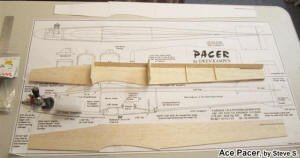
Ace Pacer under construction by Steven S.
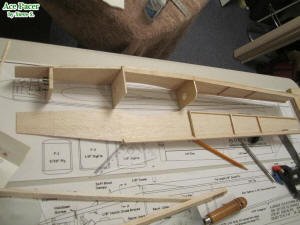
Pacer sides and formers.
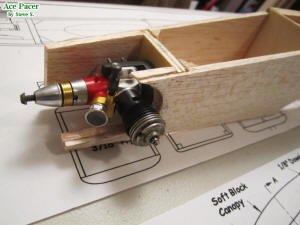
Cox TeeDee .049 mounting.
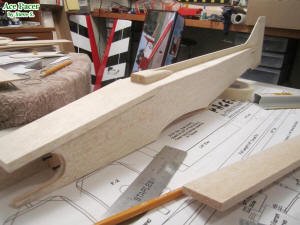
Pacer top front balsa block ready for carving.
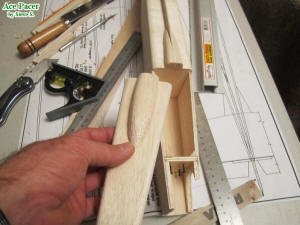
Pacer top forward deck and canopy.
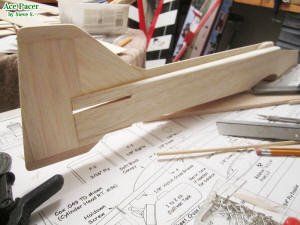
Pacer vertical fin and rudder.
All flight tests were conducted using the Ace Digital Commander and two Bantam
servos. Performance was flawless, and weight kept to a minimum. The advantage of
this system is the ability to adapt the flight package to any transmitter, thus
eliminating duplication. The elevator servo was mounted to the fuselage with tape.
Aileron hook-up prohibits the use of Bricks. In any event, avoid the use of the
larger RC systems, as a light wing loading (less than 14 ounces per square foot)
is critical to optimum performance.
CONSTRUCTION
The following will be kept to a minimum, for several reasons. (1) This is not
a beginners' model, and should not be attempted by those with little experience.
(2) The plans are quite complete and reasonably self-explanatory. (3) The author
has an aversion to reading (and writing) one more tedious piece on how to glue stick
A to stick B. Construction is as simple and direct as possible, which results in
an absolute minimum of building time.
Author's Note: A prolonged winter in Wisconsin made it advisable to ship the
plane to the warmer climate of Missouri for first night tests.
Wing: Three sections of Ace foam wings, two tapered and one
5 3/4" straight piece, are available from Ace RC. These are cut as shown on the
plans, to achieve a raked leading edge. The trailing edge stock should be 3/4 x
1/4", to fit the airfoil contour. Five-minute epoxy works fine for all foam to foam
joints. The glass strapping tape is essential for wing stiffness, and can be carried
over the top if inverted maneuvers are your specialty. Wing covering is a must,
and here Solarfilm fills the bill best, with its combination of light weight and
low heat requirements which prevent foam melting. A wide variety of colors are available,
but light, bright ones are best for visibility. Avoid gaps between wing and ailerons;
Solarfilm hinges were used on the original.
The Hoerner-type wing tips are a little extra work, but they definitely contribute
to low-speed stall characteristics and certainly improve tracking. Note: Foam wings
vary slightly, so make sure that the wing is mounted with 0° incidence. Measure
center of LE to center of TE, and line up with the stabilizer.
Fuselage: Basically this is a round-shouldered box and, once
all doublers are contact-glued in exact position, you are almost there. Note the
full length rudder post, which is installed in one piece - then cut through for
the stab to slide in place. Make sure that the dorsal back and fin are true on the
centerline. The original has a side mounted engine for a cleaner profile. Make sure
the needle valve faces UP! This can be done easily by simply loosening the venturi
and reversing the needle valve assembly.
Tail: Use reasonably stiff balsa, and cover top and bottom to
prevent warps.
That's about it. Now there's nothing more to do except wait for the first guy
to come up with a 60 version. Good luck, Pioneers!
The author expresses a large thanks to Tom Runge-who contributed so heavily to
this production.
FLIGHT TEST REPORT TOM RUNGE
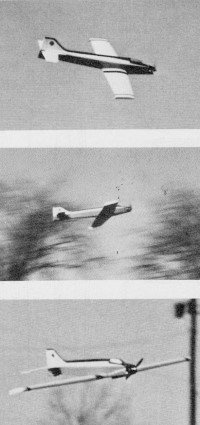 FLIGHT DATA FLIGHT DATA
Weight-22 oz. w/450 mah batteries CG-2 1/4" from LE Elevator Throw -
3/8" Total (± 3/16") Aileron Throw-3/16" Total (± 3/32") Engine-Cox Tee
Dee 049 w/ Kirn-Kraft
Needle Assembly Tank-2 oz. (Sullivan SS3) Radio-Ace Digital Commander
w/2 Bantam Servos Functions-Ailerons & Elevator
FLIGHT CHARACTERISTICS
Air Speed-60-70 mph
Trim-With wing/stab/thrust at 0°, and CG at 2 1/4" plane flies straight and
level with all surfaces in neutral. Inverted flight requires only slight amount
of down trim to maintain level flight.
Turning-Quick, linear response from neutral. Makes groovy, sweeping elevator
turns, characteristic of a low-wing, performance airplane design. No tendency to
fall off in steep bank turns.
Roll-Performs sustained axial rolls, with a minimum of down elevator in inverted
position. Roll rate is fast enough to do three rolls in less than 100 yards.
MANEUVERS
Inside & Outside Loops-has enough power to do nice big graceful loops.
Vertical Roll-OK.
Horizontal, Cuban and Reverse Cuban Eights-no problem!
Double Immelmans - great!
Top Hat-without a throttle, gets awfully fast on the downhill leg, but will do.
Spins, Snap Rolls, Four-Point Rolls - rudder is necessary.
ADDITIONAL COMMENTS
The pilot is not competent beyond this point, but plane is capable of more. The
plane glides amazingly long and flat. Even though I was expecting it, I still overshot
the runway on the first flights. Ailerons remain effective up to stall speed, which
is very slow (less than 15 mph).

Pacer Plans <click for larger
version>
Notice:
The AMA Plans Service offers a
full-size version of many of the plans show here at a very reasonable cost. They
will scale the plans any size for you. It is always best to buy printed plans because
my scanner versions often have distortions that can cause parts to fit poorly. Purchasing
plans also help to support the operation of the
Academy of Model Aeronautics - the #1
advocate for model aviation throughout the world. If the AMA no longer has this
plan on file, I will be glad to send you my higher resolution version.
Try my Scale Calculator for
Model Airplane Plans.
Posted October 21, 2010
|





